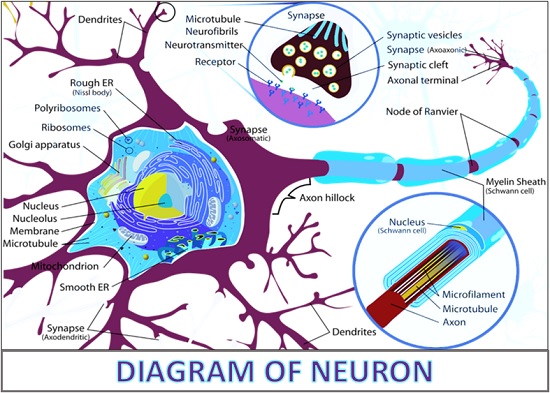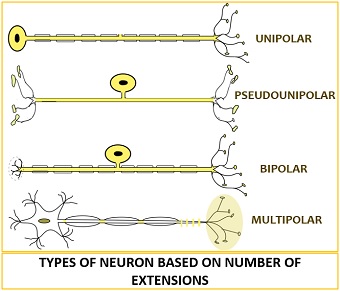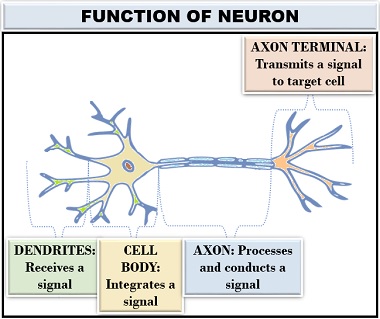Neurons are the fundamental components of the nervous system that perform a specific task by receiving, conducting, and transmitting the signal or action potential to the other parts of the body.
An electrical signal produced by the neurons is called a Nerve impulse that propagates via continuous and saltatory conduction. The term neuron is sometimes interchangeable with the term nerve-cell and nerve-fibre.
A neuron includes three functional elements like a cell-body, dendrite and an axon. Its size and shape may vary in different species. This post discusses the definition, important facts, parts, types and functions of the functions.
Content: Neurons
Definition of Neuron
Neurons refer to the morphologically and functionally distinct nerve fibres, which have root-like dendrites (receive a signal), irregular cell body (conducts the signal), and axons or the specialized projections (process and transmit a signal via synapse from one cell to the other).
Despite being unique from the other cells, it shares some common features like the presence of cell membrane, cell-nucleus, cell-organelles etc. Neurons merely refer to the excitable cells, which can respond to the stimulus by generating a nerve impulse or action potential.
Important Facts About Neurons
- Neurons are the indispensable units in our nervous system, which control all the actions or moves of our body by producing a nerve impulse.
- A single neuron comprises nearly 1000-10,000 synapses.
- A nerve impulse merely refers to a signal produced due to synaptic transmission that reaches our brain, and ultimately our brain converts that signal into an action.
- The propagation of nerve impulse from the neural surface ranges between a speed of 0.5-130 meters per second.
- Neurons do not regenerate once they die.
- In year 1998, an article was published where it has mentioned that a hippocampus region of our brain can produce new neurons in adults. The research is continued on the process of neurogenesis.
- Neurons contribute up to 10% of the brain.
- DRG (Dorsal Root Ganglion) has the most prolonged axon up to 1 metre in length, which carries the information from the skin cell receptors to the brain.
- Unlike other cells, neurons can communicate with one and another via electrical and chemical synapses.
- Electrical synapse is very uncommon but works faster and occurs during the time of defensive reflexes. It causes a bidirectional flow of information.
- Chemical synapse triggers complex reactions, but it is comparatively slower than the electrical synapse.
Parts of Neurons
It includes three distinct structural elements:

Cell Body
Soma or cell body measures 10-25 mm in diameter. Cell body functions as a “Core of neuron” that provides energy to generate a nerve impulse and structural integrity. It carries genetic information inside the nucleus. A nucleus is encircled by a membrane, and it contains nucleolus that helps in ribosomal synthesis or mediates protein translation.
A cell body is quite irregular in appearance. It comprises cell organelles like endoplasmic-reticulum, Golgi body, and mitochondria that facilitate the release of protein precursors, packaging of proteins and produce energy to fuel the cellular activities, respectively.
Nissl ribosomal bodies are the structural elements present within the cell body that also participate in protein synthesis. Microfilaments or neurotubules are the structures contributing structural support to the nerve fibres.
Dendrites
A dendritic tree emerges out from the surface of the cell body in a vast number. Further, it becomes branched to constitute a dendritic spine. Dendrites refer to the cellular extensions of the cell body, which functions as an input system that receives a signal from the other neuron via dendritic spines.
It may receive multiple signals through its dendritic tree, which can be one of the two (excitatory or inhibitory) signals. Dendrites possess ribosomes but lack a myelin insulating layer. The number of dendrites per neuron can be many.
Axon
It seems like a tubular, long, and filamentous structure, which protrudes outward from the cell body. Like dendrites, axons also form branches towards an end and make up an axon terminal. The axon endings give rise to a structure known as “Bulbous swelling”.
An axon terminal contains synaptic vesicles, which produce neurotransmitters to excite the adjacent neurons. It lacks ribosomes but contains a myelin insulating membrane.
A neuron constitutes a single axon whose length and diameter varies from species to species. The function of the axon is to conduct signals from the axon terminal to the target cells. An axon possesses the following specialized regions:
- Axon hillock is the junction element between the cell body and axon, which contains voltage-dependent sodium channels and has a negative threshold potential.
- Glial cells are non-neuronal cells. When the glial cells form myelin in the peripheral nervous system, they are called Schwann or neurilemma cells. When the glial cells form myelin in the central nervous system, they are known as oligodendrocytes. Thus, glial cells play a significant role in forming an insulating myelin layer around the axon tail.
- Myelin insulating membrane contributes to the outer layer of axon or myelin sheath, which protects cells against degeneration and accelerates information flow. The slow breakdown of myelin can cause multiple sclerosis.
- Nodes of Ranvier are the small periodic gaps (1-2 mm) in the myelin coating. In simple words, they appear in the middle of adjoining Schwann cells. They speed up the signal flow by allowing the jumping of a signal from one gap to the other.
Types of Neurons
The neurons are categorised into the following kinds based on the number of extensions from the cell body and functional role.

Based on the Number of Extensions
Unipolar: It has a single extension that originated from the cell body, also called neurite. Unipolar kind of neuron is only found in invertebrates, commonly in insects. It is electrically inactive.
Pseudounipolar: It also consists of a single extension, which bifurcates into two individual branches. One branch extends into the direction of the peripheral nervous system, and the other into the direction of the central nervous system. Pseudounipolar neurons are generally sensory or afferent neurons, which pass signals from the peripheral system to the CNS.
Example: Dorsal root ganglion neuron.
Bipolar: In this kind, a cell body contains two extensions, one axon and one dendrite. They are the specialized sensory neurons responsible for the transmission of sensations.
Example: Retinal and olfactory epithelium cells.
Multipolar: It constitutes majorly in the central nervous system and comprises motor neurons and interleukins.
Example: Motor and interneurons are of a multipolar type.

Based on Function
Sensory neurons are the pseudounipolar neurons whose function is to convey the message about the things going in our surrounding to the sensory receptors of the central nervous system like the brain and spinal cord.
It can transmit both physical and chemical signal input throughout the central nervous system. Sensory neurons are the afferent or arriving nerve fibres extending towards the central nervous system from the sensory cell receptors.
Interneurons are the “Relay neurons” that serve as neutral intermediaries. Interneurons associate with the other neurons to transfer the action potential between the sensory and motor neurons.
Motor neurons are the multipolar neurons whose function is to convey a message from the CNS through the interneurons to the peripheral effector cells like muscle, gland and organs.
Thus, their primary purpose is to conduct the signal from CNS to the skeletal and smooth muscles. Motor neurons are the efferent or exiting nerve fibres, which take multiple signals from the central nervous system and deliver them to the peripheral effector cells. Motor neurons are basically of two types:
- Upper motor nerve: It is extended between the brain and spinal cord.
- Lower motor nerve: It conducts signals from the spinal cord to the muscle cell.
Functional Role
Neurons or nerve fibres are specialized for processing and transmitting cellular signals, coordination between the cells performing different cellular activities, etc. In the structure of a neuron, all the components play a distinct role:

Dendrites functions as a receiver of the signal. Cell body functions as an integrator of the signal. Axon performs conduction of the signal to the axon terminal. Axon terminal performs transmission of the signal to other neurons.
